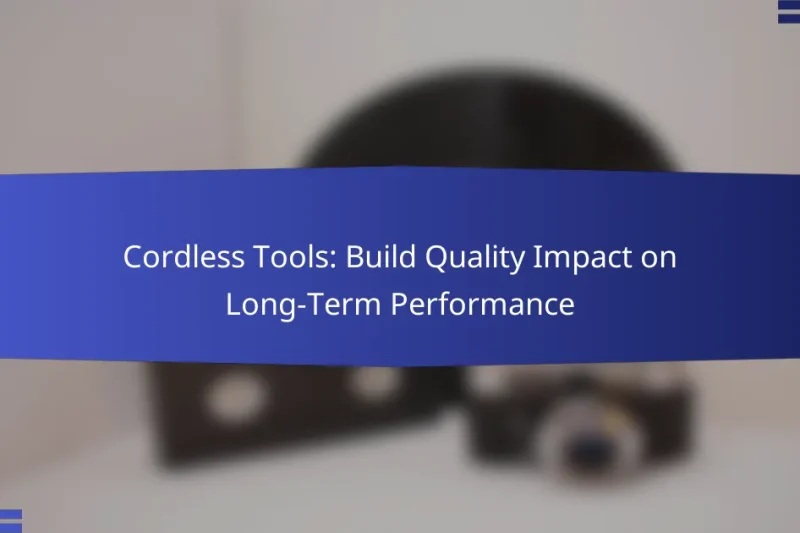Build quality is a crucial factor in the long-term performance of cordless tools, directly affecting their … Cordless Tools: Build Quality Impact on Long-Term PerformanceRead more
Cordless Tools: Durability and Build Quality
When it comes to cordless tools, durability and build quality are paramount for ensuring reliable performance over time. High-quality materials like steel and impact-resistant plastics play a crucial role in enhancing the strength and longevity of these tools. Brands such as DeWalt, Makita, and Milwaukee are renowned for their robust designs, making them trusted choices for both professionals and DIY enthusiasts alike.
Cordless Tools: Weather Resistance, Harsh Environments and Durability
When working in harsh environments, choosing the right cordless tools is essential for maintaining performance and … Cordless Tools: Weather Resistance, Harsh Environments and DurabilityRead more
Cordless Tools: Warranty, Repair Options and Longevity
When investing in cordless tools, it’s essential to understand the warranty options available, including manufacturer and … Cordless Tools: Warranty, Repair Options and LongevityRead more
Cordless Tools: User Reviews, Durability Insights and Brand Comparisons
When selecting cordless tools for home improvement, it’s crucial to evaluate their performance, durability, and brand … Cordless Tools: User Reviews, Durability Insights and Brand ComparisonsRead more
How does durability impact cordless tool performance?
Durability significantly influences cordless tool performance by ensuring tools can withstand demanding tasks over time. A durable tool maintains its functionality and effectiveness, reducing the likelihood of failure during use.
Longer lifespan
A durable cordless tool typically has a longer lifespan, which means it can be used effectively for many years without needing replacement. High-quality materials and robust construction contribute to this longevity, allowing users to get more value from their investment.
For example, a well-built cordless drill may last several years in a professional setting, while cheaper alternatives might only function adequately for a few months. Choosing tools with a reputation for durability can save money in the long run.
Consistent reliability
Durability leads to consistent reliability, meaning that a well-constructed cordless tool will perform effectively under various conditions. This reliability is crucial for professionals who depend on their tools to complete tasks efficiently without unexpected breakdowns.
For instance, a durable impact driver can handle tough materials like hardwood or metal without faltering, ensuring that projects stay on schedule. Users should prioritize tools that have proven track records for reliability in their specific applications.
Reduced maintenance costs
Investing in durable cordless tools often results in reduced maintenance costs over time. Tools that are built to last require less frequent repairs and replacements, which can significantly lower overall expenses.
For example, a high-quality battery-operated saw may need only occasional blade replacements, while a less durable model might require more frequent servicing. Users should consider the long-term costs associated with tool maintenance when selecting cordless tools, opting for those that offer durability and lower upkeep needs.
Which brands offer the best build quality for cordless tools?
Brands known for their exceptional build quality in cordless tools include DeWalt, Makita, and Milwaukee. These manufacturers consistently deliver durable products that withstand rigorous use, making them favorites among professionals and DIY enthusiasts alike.
DeWalt
DeWalt is renowned for its robust cordless tools, often featuring high-quality materials and advanced engineering. Their tools are designed to endure heavy-duty applications, making them ideal for construction and renovation projects.
Many DeWalt products come with a three-year limited warranty, which reflects the brand’s confidence in their durability. Users appreciate the ergonomic designs that enhance comfort during extended use, reducing fatigue.
Makita
Makita is another leading brand known for its exceptional build quality in cordless tools. Their products often incorporate innovative technology, such as brushless motors, which improve efficiency and extend tool life.
Makita tools are designed with user safety and comfort in mind, featuring anti-vibration systems and lightweight designs. The brand also offers a wide range of tools, from drills to saws, catering to various professional needs.
Milwaukee
Milwaukee is recognized for its heavy-duty cordless tools that excel in performance and longevity. The brand focuses on creating solutions for professionals, ensuring their tools can handle tough job site conditions.
Milwaukee’s REDLINK PLUS intelligence system enhances tool performance by preventing overload and overheating. Many users find their tools to be highly reliable, making them a popular choice among tradespeople who require consistent performance.
What materials enhance the durability of cordless tools?
Durability in cordless tools is significantly influenced by the materials used in their construction. High-grade steel, impact-resistant plastics, and aluminum housings are key components that contribute to their overall strength and longevity.
High-grade steel
High-grade steel is often used in the manufacturing of cordless tool components such as gears and blades. This material provides excellent resistance to wear and tear, ensuring that tools maintain their performance over time. When selecting cordless tools, look for those that specify the use of high-grade steel for critical parts.
Additionally, tools made with high-grade steel tend to withstand higher torque and stress, making them suitable for heavy-duty applications. Consider brands that highlight their use of premium steel in their product descriptions for better durability.
Impact-resistant plastics
Impact-resistant plastics are commonly used in the housings of cordless tools to protect internal components from damage. These materials are designed to absorb shocks and resist cracking, which is essential for tools that may be dropped or subjected to rough handling. When evaluating cordless tools, check for mentions of impact-resistant features.
Moreover, impact-resistant plastics can help reduce the overall weight of the tool, making it easier to handle during prolonged use. Look for tools with reinforced plastic casings for added durability without sacrificing portability.
Aluminum housings
Aluminum housings are favored in many cordless tools for their lightweight and corrosion-resistant properties. This material not only enhances the tool’s durability but also contributes to a more balanced weight distribution, improving user comfort during operation. Tools with aluminum housings are often more resilient to environmental factors, such as moisture and temperature changes.
When choosing cordless tools, consider those with aluminum housings for a combination of strength and lightweight design. This can be particularly beneficial for professionals who use tools extensively in various conditions.
How to assess the build quality of cordless tools?
To assess the build quality of cordless tools, focus on user reviews, warranty policies, and certifications. These factors provide insights into durability, reliability, and overall performance, helping you make an informed decision.
Check user reviews
User reviews are a valuable resource for evaluating the build quality of cordless tools. Look for feedback on durability, ease of use, and performance over time. Pay attention to reviews that mention specific issues, as these can indicate potential weaknesses.
Consider checking multiple platforms, such as retail websites and dedicated tool forums, to get a well-rounded view. A tool with a high number of positive reviews is often a good indicator of solid build quality.
Examine warranty policies
Warranty policies can reveal a manufacturer’s confidence in their product’s build quality. A longer warranty period typically suggests that the manufacturer expects their tool to last and perform well. Look for warranties that cover both parts and labor.
Be cautious of tools with limited warranties, as they may indicate lower durability. It’s also wise to read the fine print to understand what is covered and any conditions that may apply.
Look for certifications
Certifications can serve as a benchmark for the quality of cordless tools. Look for tools that meet industry standards, such as ISO certifications, which indicate adherence to quality management principles. Certifications can also include safety standards relevant to your region.
Tools with recognized certifications are often more reliable and durable, as they have undergone rigorous testing. Always check for these marks before making a purchase to ensure you are investing in a quality product.
What are the key features of durable cordless tools?
Durable cordless tools are characterized by their ability to withstand various environmental conditions while maintaining performance. Key features include weather resistance and shock absorption, which enhance longevity and reliability during use.
Weather resistance
Weather resistance in cordless tools refers to their ability to function effectively in different climatic conditions, such as rain, humidity, and extreme temperatures. Tools with high weather resistance often have protective seals and coatings that prevent moisture and dust from entering critical components.
When selecting weather-resistant tools, look for those rated with an IP (Ingress Protection) rating of at least IP54, which indicates protection against dust and splashes. This ensures that the tool can handle outdoor use without significant risk of damage.
Shock absorption
Shock absorption is crucial for cordless tools, especially when used in demanding tasks or dropped accidentally. Tools designed with shock-absorbing features, such as rubber grips or internal cushioning, help to minimize the impact on internal components, prolonging their lifespan.
Consider tools that incorporate advanced materials or designs specifically aimed at reducing vibration and shock. This not only protects the tool but also enhances user comfort during prolonged use, making it easier to handle without fatigue.



